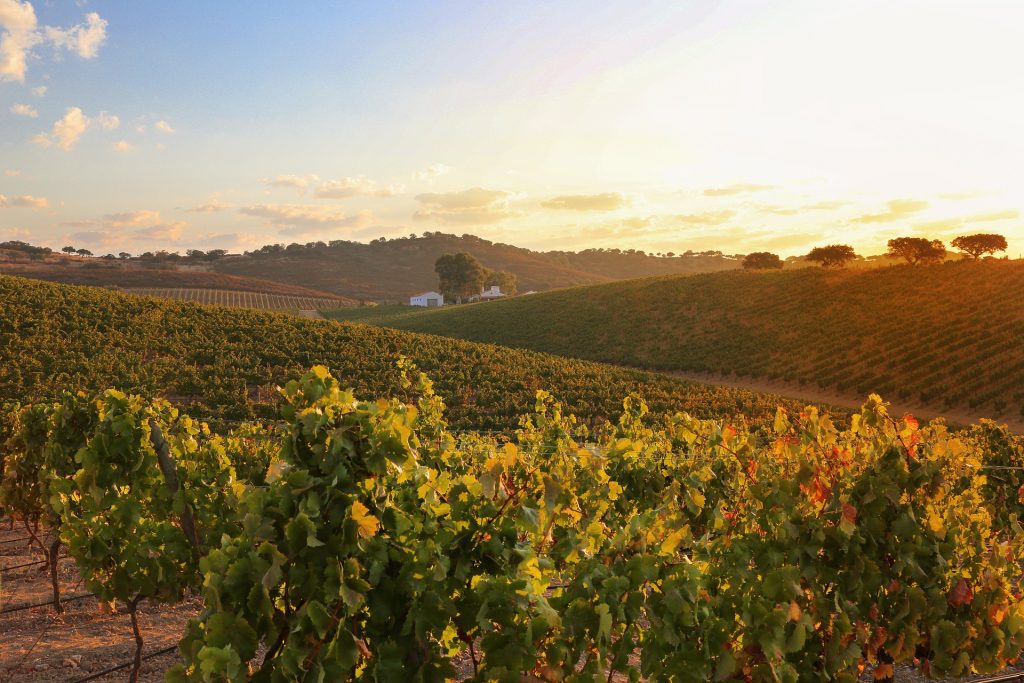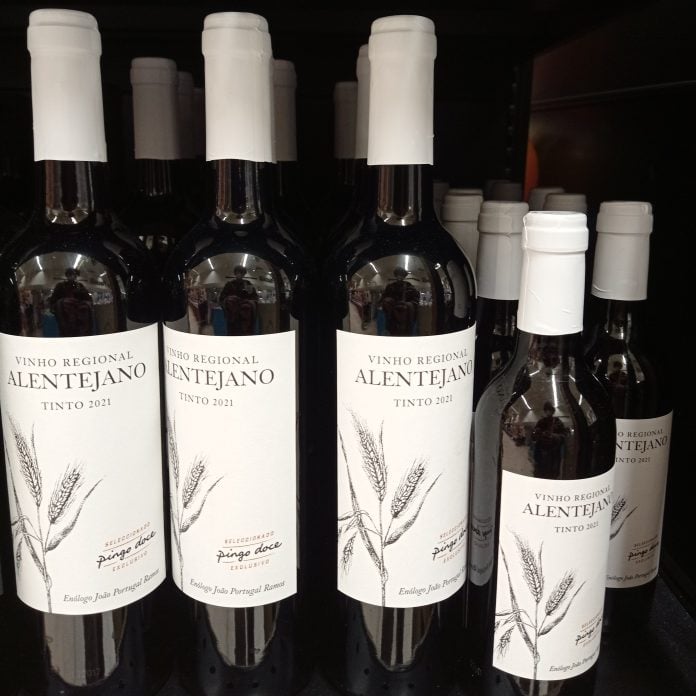Alentejo is a Portuguese region situated on the South of the Tagus River and North of the Algarve region, the far-south of the country. It covers about a third of the country and is very sparsely populated, known for its olive oil and cork production, as well as its beautiful architecture. However, it is one of the main wine producing regions of Portugal. [Read our full guide to Portuguese Wine covering all 14 wine regions]
While not thought of as traditional wine country, due to its hot and dry climate and the landscape usually thought as filled with olive trees, there are many parts of the region that produce great quality wines that are now on the maps of the best Portuguese and even world wines!
Any wine produced in the region can use the ‘Vinho Regional Alentejano’ (Alentejan Regional Wine) seal, but some areas are also classified as a DOC (‘Denominação de Origem Controlada’ or Controlled Origin Denomination).
This is a region with millennia of wine making history, and with traditions that go back to that same period. The traditional ‘Vinho de Talha’ is made the exact same way as the Romans used to do it more than two millennia ago.
Now with much more technology and with a troubled history, this wine has become one of the most liked wines in the country. So check it out and if you become interested, have a try.
History
The history of wine production in the Alentejo region is thought to have been started by the Romans. We can still find leftovers of the traditional winemaking processes used by the Romans in the Alentejo winemaking way, like the fermentation being made in clay pots.
The region is filled with history from then on. It’s in this region (together with Algarve) that you can see the biggest influence of the Arab occupation, be it in the names of the villages, in their traditions, arts, culture and, obviously, in the architecture of Alentejo.
However, for its wines, it was in the 17th century that they first started to get famous and considered prestigious in Portugal. This bothered the Marquis of Pombal, at the time probably the most powerful person in Portugal, assuming the role of basically a prime-minister.
The Marquis had an interest in the Douro wine region, so the rise of Alentejo would pull the Douro wine price down. That’s why he ordered all of the vines in Alentejo to be ripped from the ground, practically destroying the region’s vines.
Thankfully, from then on, several measures were put in place to help recover the area, like the creation of the first Social Winery in Portugal and the Winemaking Project of Alentejo (PROVA). These projects are usually supported by the local wine commission, the Comissão Vitivinícola Regional Alentejana (CVRA), and other organs connected to the wine trade.
The CVRA, created in 1989, is the association responsible for promoting the Alentejo wines, both in the national markets and in the international ones. It’s also responsible for controlling and protecting the wines with the DOC Alentejo symbol, as well as the IG Alentejo symbol. All of the wine producers in the region that want to use the DOC or IG seal on their wines, have to ask for certification from the CVRA. It is a great organism to maintain the quality and tradition of the regions wines.
Vinho de Talha
This traditional process that still exists in Alentejo is millennia old, coming from the Romans. And it hasn’t changed a lot in more than 2000 years.
It involves a clay pot, or concrete as many of the more recent ones are, that’s used to both produce and store the wine (yes, made and stored in the same pot). Generally, what happens is the grapes are put inside the pots and then the fermentation happens spontaneously.
Vila de Frades, a small Alentejan village, is considered the capital of ‘vinho de talha’, even hosting an event dedicated to this wine on the second weekend of December, with a visit to the typical wineries of the village and winetasting included on the last day.
It’s been planned by the City Hall of Vidigueira to apply this winemaking method to the level of UNESCO Intangible Cultural Heritage.
Subregions
The region is divided in 8 subregions, that you can find on the label together with the name of the region as a whole, ‘Alentejo’ (Alentejo-Portalegre, for example).
Together, these regions count with more than 250 wine producers and more than 20.000 hectares of total vineyard land (11.000, if we just count the DOC region). This is 10% of all the wine area in the country!
These subregions were, at first, created as separate IPR regions (‘Indicação de Proveniencia Regulamentada’, or Indication of Regulated Origin). Then, some of these were elevated to DOC regions until, in 2003, all of the region’s DOCs and remaining IPRs were grouped together in the Alentejo DOC.
This way, these are the Alentejo DOC subregions:
- Portalegre
- Borba
- Redondo
- Évora
- Reguengos
- Granja-Amareleja
- Vidigueira
- Moura

Climate and Soil
The Alentejo soils are very diverse! We can find clay, schist, granite, marble or limestone in the various soils. This diversity makes it perfect for vine production and wines with different properties. However, they are also the poorest soils in the country, due to them being very dry.
The terrain is much more flat than on most of the other regions, except in Portalegre, where hilly terrains are mostly used.
As for the climate, it’s also ideal for winemaking. It’s a very hot climate with a lot of sunlight in the summer, and a dry cold in the winter. This creates extraordinary grapes, with a combination of maturity and freshness!
A few years back, most of the Alentejo vineyards started using ‘integrated protection’ of the vines, reducing significantly the pesticides it uses and, when it has to use, selecting the least toxic ones and only using what’s necessary.
But of course, to make it the great wine that it is, the wisdom of the local winemakers is needed, so that we can have that unique and traditional wine.
Grape and Wine Types
In Alentejo, besides all the native grape types that already print in the region’s wines a strong regional character, there are other foreign varieties that have been more recently introduced. These are grapes that have a lot of value in the international markets and to the connoisseurs, strengthening Alentejo’s wine leadership.
The main grape types used in Alentejo are:
- Red Wine Grapes: Aragonez; Trincadeira; Castelão; Alicante Bouschet; Alfrocheiro; Touriga Nacional; Syrah; Cabernet Sauvignon
- White Wine Grapes: Antão Vaz; Arinto; Roupeiro; Fernão Pires
The region produces white, red rosé and sparkling wines:
- White Wines: They have a firm structure, low levels of acidity, highly aromatic in flavor (with citrus hints) and are full-bodied.
- Red Wines: Being usually made from different grape types blended together, these wines are also full-bodied, with a rich color and the perfect level of acidity. They have an amazing balance between tannins and alcoholic levels.
- Rosé Wines: unique wines with a strong aroma, very smooth and well rounded. They can be enjoyed while young but also age in an incredible good way.
Suggestions
If you’re looking to try out some of this Southern Portuguese wine, here are some of the many brands that you can trust to give you a good experience (among many others):
- Herdade dos Grous
- Antão Vaz da Peceguina
- Poliphonia
- Adega de Borba
- Tapada de Chaves
- Quinta do Mouro
- Terrenus
- Zambujeiro
- Dona Maria
Tours
Great Tasting Honored Vineyards
Visit the capital of the ‘Vinho de Talha’, Vila de Frades, in this amazing tour that will take you to the Talha de Honrado Vineyards for a taste of 4 different wines from the Alentejo DOC region. Compare them and learn more about this ancestral technique!
This cellar-museum with centuries of history will immerse you into the best of the history, culture and tradition of this old and interesting tradition.
Monsaraz: Departing from Évora
Leave the wonderful city of Évora (just for a while) to explore the historic village of Monsaraz! Its breathtaking views from the hilltops will leave you in awe and roaming through its streets will make you travel back in time.
On the way there, why not stop at a small village with a family-owned pottery and learn more about the regions ceramics while talking to the charming locals?
Obviously, this amazing day couldn’t finish without a tasting of the region’s unique wines at a local winery, so you can have a full cultural immersion in the Alentejan lifestyle!
Alentejo Wine Region and Évora Day Trip from Lisbon
Starting from Lisbon, go to this incredible region south of the Tagus River to experience the historical beauty and culture of Évora. Explore this UNESCO World Heritage Site and all of its landmarks.
Then, enjoy a traditional Alentejan lunch and finish the day with a visit to a wine cellar, complete with wine tasting. Tour around the vineyards and try the famous Alentejan wines before returning to Lisbon to rest from this full day.


